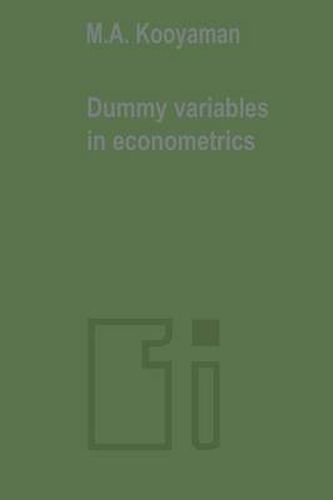Readings Newsletter
Become a Readings Member to make your shopping experience even easier.
Sign in or sign up for free!
You’re not far away from qualifying for FREE standard shipping within Australia
You’ve qualified for FREE standard shipping within Australia
The cart is loading…






This title is printed to order. This book may have been self-published. If so, we cannot guarantee the quality of the content. In the main most books will have gone through the editing process however some may not. We therefore suggest that you be aware of this before ordering this book. If in doubt check either the author or publisher’s details as we are unable to accept any returns unless they are faulty. Please contact us if you have any questions.
Dr. Kooyman has made a careful study of the econometric model used around 1963 by the Netherlands Central Planning Bureau, especially of eight of its most import ant behavioural equations. The Bureau used coefficients estimated from a pre-war and a post-war time series simultaneously, in order to have a larger number of observations. The author, being aware of the difference in general economic ‘climate’ in the two periods, tests the assumption of no difference in pre-war and post-war coefficients. In an inventive way he uses a few alternat ive approaches. On the basis of his findings he concludes that a new specification of some of the equations is necessary. Since the Dutch model is likely to be the oldest of its type, foreign readers may be interested in reading Dr. Kooyman’s text - slightly adapted - in English. J. Tinbergen v Preface The first edition of this book appeared in Dutch as a thesis which was defended at the State University of Groningen in 1971. When working on this publication I received much help from Dr. H. Rijken van Olst and Dr. G. F. W. M. Pikkemaat, professors at the State University of Groningen of, respectively, statistics and econometrics, and mathematical economics. I would like to thank Prof. dr. J. Tinbergen, who aroused my enthusiasm for quantitative economics during my college years at the Netherlands School of Economics: I am much obliged to him for his willingness to write a foreword.
$9.00 standard shipping within Australia
FREE standard shipping within Australia for orders over $100.00
Express & International shipping calculated at checkout
This title is printed to order. This book may have been self-published. If so, we cannot guarantee the quality of the content. In the main most books will have gone through the editing process however some may not. We therefore suggest that you be aware of this before ordering this book. If in doubt check either the author or publisher’s details as we are unable to accept any returns unless they are faulty. Please contact us if you have any questions.
Dr. Kooyman has made a careful study of the econometric model used around 1963 by the Netherlands Central Planning Bureau, especially of eight of its most import ant behavioural equations. The Bureau used coefficients estimated from a pre-war and a post-war time series simultaneously, in order to have a larger number of observations. The author, being aware of the difference in general economic ‘climate’ in the two periods, tests the assumption of no difference in pre-war and post-war coefficients. In an inventive way he uses a few alternat ive approaches. On the basis of his findings he concludes that a new specification of some of the equations is necessary. Since the Dutch model is likely to be the oldest of its type, foreign readers may be interested in reading Dr. Kooyman’s text - slightly adapted - in English. J. Tinbergen v Preface The first edition of this book appeared in Dutch as a thesis which was defended at the State University of Groningen in 1971. When working on this publication I received much help from Dr. H. Rijken van Olst and Dr. G. F. W. M. Pikkemaat, professors at the State University of Groningen of, respectively, statistics and econometrics, and mathematical economics. I would like to thank Prof. dr. J. Tinbergen, who aroused my enthusiasm for quantitative economics during my college years at the Netherlands School of Economics: I am much obliged to him for his willingness to write a foreword.